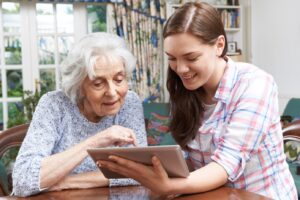
Technology changes fast, and for many seniors, keeping up with new devices or apps feels intimidating. Yet digital skills are no longer optional. They help older adults stay in touch with loved ones, manage healthcare, and explore hobbies online. Caregivers play a vital role in bridging the gap. With patience and practical strategies, they can guide seniors toward using technology with confidence.
Why Tech Skills Matter for Seniors
Staying digitally connected allows seniors to feel less isolated and more independent. Video calls bring family members into their living rooms, while health apps track medication schedules and appointments. Online platforms also provide entertainment, education, and ways to connect with community groups. For many older adults, mastering technology is essential for remaining socially engaged and maintaining mental acuity.
The Role of Caregivers in Building Confidence
Learning new technology often stirs up fear of failure. Seniors may worry about breaking devices or making mistakes they cannot undo. Caregivers help by reassuring them that errors are part of the process. Gentle encouragement, celebrating small wins, and avoiding overly technical language all build trust. When seniors feel supported, they are more inclined to explore and continue practicing.
Practical Teaching Approaches for Seniors
Caregivers can make the process easier by breaking lessons into small, manageable steps. Repetition and clear demonstrations often work better than long explanations. It also helps to connect technology to real-life benefits, such as showing how to send photos to grandchildren or schedule a doctor's appointment online.
Here are the essential teaching approaches:
- Start with the basics
- Repeat key steps
- Use real-life examples
- Encourage hands-on practice
- Celebrate small progress
Encouraging Independence Through Practice
Independence grows when seniors can repeat tasks on their own. Caregivers should resist the urge to take over, even if it feels quicker. Instead, they can watch and guide while the senior completes each step. Over time, confidence builds. A grandmother who once avoided smartphones may begin video calling weekly. A grandfather unsure of online forms may start paying bills electronically. In the process, technology shifts from a source of stress to a source of empowerment.
Some caregivers also introduce trusted websites and tools to make the learning process engaging. Seniors interested in helping younger family members with schoolwork, for example, might explore resources together. A grandparent can sit with a teenager researching an assignment and discover platforms such as EssayHub writing service to write my essay with, seeing firsthand how online tools support learning. These shared experiences strengthen bonds across generations and show seniors the broader value of technology.
Common Challenges and How to Overcome Them
Even with the right approach, barriers remain. Caregivers need to anticipate common obstacles:
- Many seniors struggle with touchscreens, so caregivers should introduce styluses or larger devices.
- Memory issues can hinder recalling steps, so using written guides with pictures can be helpful.
- Fear of scams creates anxiety, so teaching safe browsing practices is essential.
- Hearing or vision impairments may block progress, so enabling accessibility features should be an early step.
- A lack of patience from either side can discourage learning, so pacing lessons carefully is crucial.
Creating a Supportive Learning Environment
A calm, welcoming atmosphere makes learning far less intimidating. Sessions should happen in quiet spaces without distractions, with devices set up beforehand. Patience is the key ingredient. Seniors need time to process new information, and lessons should end on a positive note.
Education specialists emphasize this balance. Jennifer Lockman, who collaborates with students and families through the essay writing service EssayService, observes that seniors thrive when lessons feel personal rather than mechanical. She explains that the same principles used to teach students, like clarity, repetition, and encouragement, also apply to older learners. With the right approach, seniors can adapt quickly and even surprise themselves with what they achieve. For example, just as students benefit from step-by-step guides on how to write an essay, seniors benefit from structured, simplified instructions when approaching new technology.
Caregivers can also connect seniors to peer learning opportunities. Community centers often run technology workshops for older adults, and many libraries host "digital literacy" sessions. Pairing caregiver support with outside resources multiplies the impact, making learning a shared, motivating experience.
Conclusion
Caregivers are more than helpers in daily routines; they are bridges to a world that is constantly changing. By guiding seniors through small steps, encouraging practice, and creating supportive environments, they help older adults unlock the benefits of technology. For seniors, learning new skills means greater independence, stronger connections, and renewed confidence in their ability to thrive in a digital age.